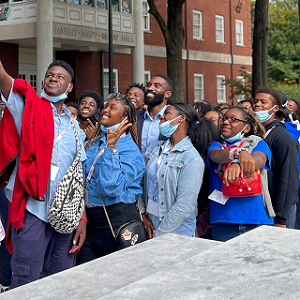Science Leadership
SRP-supported research has informed decision making at the federal and national level. For example, grantee research and expertise informed new drinking water health advisories issued by the U.S. Environmental Protection Agency (EPA) for several types of PFAS. SRP grantees also lent expertise to a new report, published by the National Academies of Science, Engineering, and Medicine, that guides clinicians in evaluating patients for PFAS exposure and addressing associated health effects.
NIEHS SRP Director William Suk, Ph.D., presented at the 19th International Conference of the Pacific Basin Consortium for Environment and Health, which convened global experts to discuss environmental exposures in a changing climate. Suk discussed the e-ASIA Joint Research Program , an initiative to facilitate collaborative international research and promote innovation in the East Asian region. Health Specialist Brittany Trottier, MPH, and Health Scientist Administrator Michelle Heacock, Ph.D., chaired poster sessions and trainee presentations covering topics ranging from prenatal exposures to quality of life in cancer patients.
In October 2022, Health Scientist Administrator Danielle Carlin, Ph.D., spoke at the 11th Conference on Metal Toxicity and Carcinogenesis about SRP support for research on metal contaminants. Her presentation covered multiple projects, including investigations into ways people encounter metals and the health effects of exposure, and how to clean up metals in the environment.
Health Scientist Administrator Heather Henry, Ph.D., has also presented at two recent sessions of the Federal Remediation Technologies Roundtable. For the Spring session, she provided an overview of SRP-supported research that uses machine learning and artificial intelligence. For the Fall session, she highlighted examples of successful technology transfer - from research and development, to field studies, and commercialization.
SRP staff and grantees also participated in the 34th Annual Conference of the International Society for Epidemiology and the International Society for Exposure Science 2022 Annual Meeting.
Health Scientist Sara Amolegbe, M.S.P.H., recently accepted a new position with the NIH Office of Strategic Coordination, where she will continue to support programs addressing cross-cutting emerging scientific opportunities and pressing challenges in biomedical research.

Jamaji Nwanaji-Enwerem, M.D., Ph.D., a former trainee with the UC Berkeley SRP Center, was the subject of a recent NIEHS Grantee Highlight. He is now an emergency resident doctor and an adjunct professor at Emory University, where he studies how environmental exposures can damage cells and impact a person's biological age, one of the risk factors for many human diseases.
Laurel Schaider, Ph.D., of the Silent Spring Institute and the URI SRP Center, appeared on a recent episode of Environmental Health Chat, a podcast series hosted by NIEHS's Partnerships for Environmental Education. Schaider leads an SRP-funded study to better understand how PFAS exposure affects children's immune systems.
Researchers at the Louisiana State University SRP Center, North Carolina State University SRP Center, and Tulane University were featured in a recent NIEHS Partnerships for Environmental Public Health Newsletter story. The story highlights how the team used community stories to identify overlap between lived experiences with pollution and a burn facility's smoke plume, which helped the scientists improve their exposure assessment technique.
to Top



